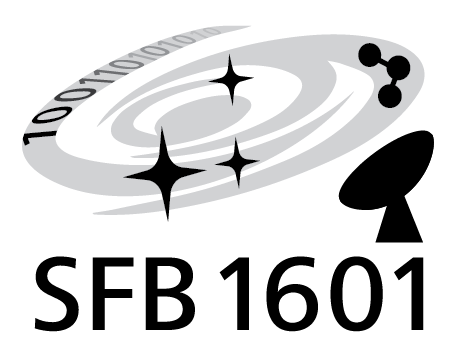-
B2: A peculiar proplyd-like object in Cygnus (Nicola Schneider, Simon Dannhauer)

Proplyds are young stars surrounded by gas and dust discs that lose material through internal and external photo-evaporation. Understanding their evolution requires measurements of gas masses and key timescales, obtained from spectrally resolved observations of the molecular and atomic gas.
We studied an isolated, globule-shaped object near the centre of Cygnus OB2, known as proplyd #7. Its nature is debated: it may host either a massive star with an HII region or a G-type T Tauri star. In both scenarios, a photo-evaporating disk inside a molecular envelope may be present. Using SOFIA OI 63 μm and CII 158 μm data, together with IRAM 30m CO observations and radio continuum at 5.9 GHz (left panel of the figure), we detected all lines across the source. The brightest OI emission (right panel) lies west of the embedded YSO (marked by a yellow star) and shows bulk emission near 11 km/s and a redshifted wing at 13 km/s.
The OI can trace either a photodissociation region (PDR) orshock-heated disc material. The KOSMA-tau PDR model reproduces theemission in the proplyd tail under a modest UV field, but not near theYSO, where strong lines, broader profiles, and a possible CO outflow point to a protostellar disc. Radio continuum data instead indicate a thermal HII region, consistent with a massive central star.
Proplyd #7 contains mostly molecular gas, with ~20 M⊙ of molecular and a few solar masses of atomic material. Its external photo-evaporation timescale (~1.6×10⁵ yr) is shorter than the free-fall time (~5.2×10⁵ yr), suggesting that little additional star formation could occur – consistent with numerical simulations.
The true nature of proplyd #7 is not yet revealed. Our study sets constraints on the timeline of the evolution of this object and highlights observational discrepancies. Upcoming NOEMA and further IRAM 30m observations will help to elucidate if we indeed observe a disc around a massive star within this object, a rare and remarkable finding.
A&A in press
DOI: https://doi.org/10.1051/0004-6361/202557227 -
B6: SILCC – IX. The multi-phase interstellar medium at low metallicity (Vittoria Brugaletta)

In our latest SILCC paper, we perform magneto-hydrodynamic simulations to investigate the impact of metallicity on the interstellar medium (ISM). In fact, gas-phase metallicity affects heating and cooling processes in the star-forming ISM as well as ionising luminosities, wind strengths, and lifetimes of massive stars. Our simulations include non-equilibrium chemistry, a space- and time-variable far-UV background and cosmic ray ionisation rate, metal-dependent stellar tracks, the formation of HII regions, stellar winds, type II supernovae, and cosmic ray injection and transport. The simulations assume a gas surface density of 10 M_sun pc−2 and span metallicities from 1/50 Z_sun to 1 Zsun. Among our results, we find that for decreasing metallicity, the star formation rate decreases by more than a factor of ten, the mass fraction of cold gas decreases from 60% to 2.3%, while the volume filling fraction of the warm gas increases from 20% to 80%. In particular, we analyze the conditions in which our stars form, computing the ratio of the H2 mass to the H mass in star-forming regions, and we find that this ratio depends on the metallicity. In fact, we find that at solar metallicity (upper panel), massive stars form in an almost fully molecular gas, whereas at extremely low metallicity (bottom panel), they form in almost fully atomic gas. Including the major processes that regulate ISM properties, this study highlights the strong impact of gas phase metallicity on the star-forming ISM.
-
C2: Vz−GAL: Probing Cold Molecular Gas in Dusty Star-forming Galaxies at z = 1 − 6 (Prachi Prajapati, Dominik Riechers, Axel Weiss, Beth Jones)
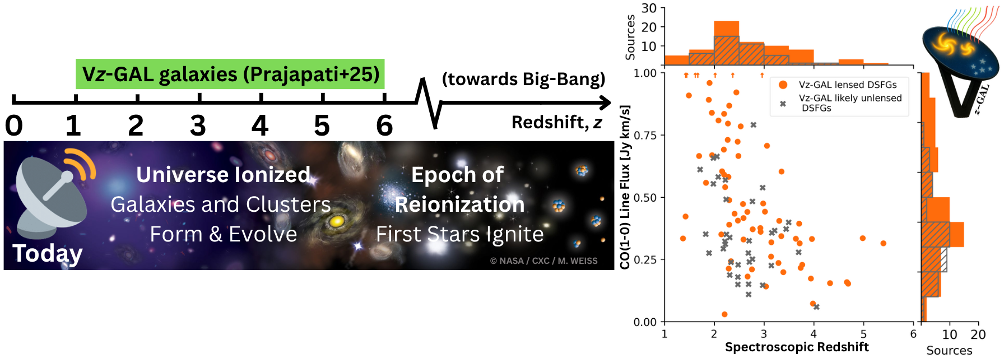
Infrared- or submillimeter-bright dusty star-forming galaxies (DSFGs) are key contributors to the cosmic star formation rate density in the early universe, preserving the imprint of its star formation history [1-2]. We are at the forefront of observations, having secured spectroscopic redshifts for about 400 DSFGs up to redshift z ~ 7. Among these, the NOEMA z-GAL is the largest sample of 135 meaningfully selected high-z DSFGs (S500µm > 80 mJy) from the Herschel fields, whose spectroscopic redshifts are robustly measured mainly using higher-J CO lines [3].
In our recent work focused on Vz-GAL, a large program using NSF’s Very Large Array (VLA), we have focused on investigating galaxy evolution by characterizing the cold gas, fuel for star formation, in 106/135 z-GAL galaxies spanning from the epoch of reionization (redshift z ~ 6, approximately 1 Gyr after the Big Bang) to the post-cosmic noon era (z ~ 1, roughly halfway through the universe’s current age). Vz-GAL targets faint CO(1-0) transition in these high-z galaxies, which is essential for accurately probing cold molecular gas and constraining gas excitation conditions, despite the observational challenges involved. Using Vz-GAL, we double the currently available CO(1-0) measurements at high-zand robustly calibrate gas masses for this homogeneously selected, flux-limited, large statistical sample.
Our analysis compares integrated CO(1-0) line luminosities (as a gas mass proxy) with total infrared luminosities (as an SFR proxy, [4-5]) to explore the Kennicutt-Schmidt correlation and redshift evolution of gas depletion timescales, revealing a galaxy’s evolutionary state. Here we compare our high-z DSFGs to local galaxy populations to understand their physical environments. In addition, rigorously derived CO excitation line ratios yield new insights into the physical state of molecular gas in the early universe. Our preliminary findings regarding gas-to-dust mass ratios and [CI]/CO luminosity ratios further emphasize the necessity for refined radiative transfer modeling fewer ad-hoc assumptions, which can characterize the star-forming interstellar medium via simultaneously fitting the spectral energy distribution of dust and CO line. We find consistent [CI](1-0)/CO(1-0) ratios across redshifts, suggesting the use of [CI](1-0) as an alternative cold gas tracer at z > 1.
We have recently submitted the paper on the Vz-GAL catalog to ApJS. Please find it on the arXiv using https://ui.adsabs.harvard.edu/abs/2025arXiv250925167P/abstract. For more details, please visit https://vzgal.uni-koeln.de.
[1] Madau & Dickinson 2014, ARA&A, 52, 415 [2] Zavala et al. 2021, ApJ, 909, 16 5 [3] Cox et al. 2023, A&A, 678, A27 [4] Ismail et al. 2023, A&A, 678, A27 [5] Berta et al. 2023, A&A, 678, A28.
-
C3: Tracing star formation in the early galaxies with FYST/CCAT: Foreground Masking (Christos Karoumpis)
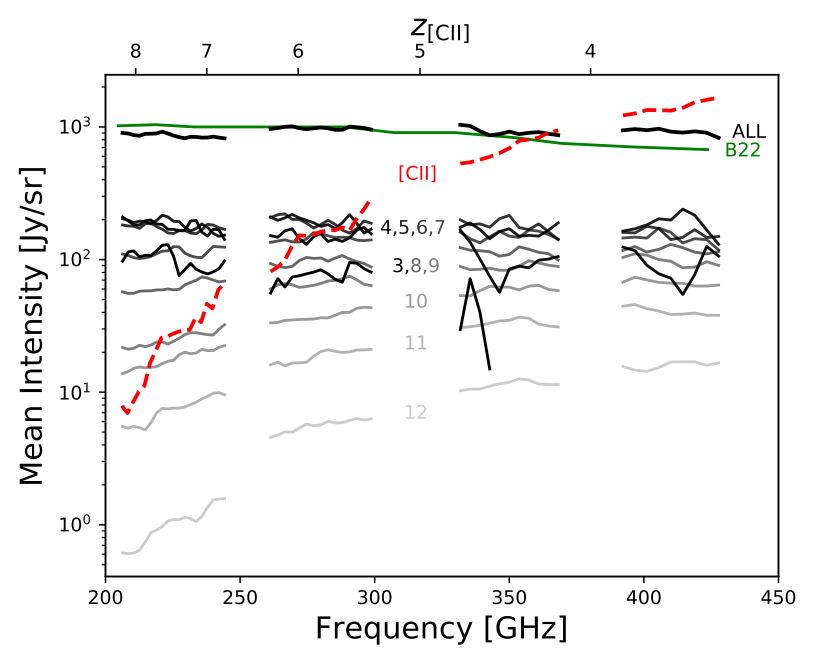
In our recent Astronomy & Astrophysics paper, we explore the prospects of using [CII] line intensity mapping (LIM) observational technique with the upcoming FYST / Prime-Cam instrument to study galaxies that formed about 0.5–1.5 billion years after the Big Bang. LIM measures the cumulative emission from many faint galaxies without resolving them individually, offering a powerful way to trace the contribution of sources too faint to be detected even with state-of-the-art telescopes. The [CII] 158 µm line is a key tracer of star formation in these early systems, but its signal is strongly contaminated by foreground CO emission from later galaxies along the line of sight.
To address this challenge, we generate mock [CII] and CO maps by post-processing the IllustrisTNG300 simulation and test a masking strategy in which bright CO emitters are identified from an external galaxy survey catalog and removed. Our results show that, without masking, CO dominates the signal at almost all observing frequencies, with the exception of the higher end of the frequency range of our telescope. After masking, the [CII] signal becomes accessible across most frequencies. At the highest frequencies, however, which probe the earliest and most distant galaxies, the CO contamination remains severe. In this regime, masking alone is not sufficient, highlighting the need for complementary techniques such as line-deconfusion or cross-correlations with other tracers.
This study demonstrates that, with the support of ancillary galaxy surveys, the [CII] LIM signal from early galaxies can be detected, a first step toward applying LIM to trace star formation within the first generations of galaxies.
-
B2: The Diamond Ring in Cygnus X – Environment shapes evolution (Simon Dannhauer, Nicola Schneider, Robert Simon, Sebastian Vider)
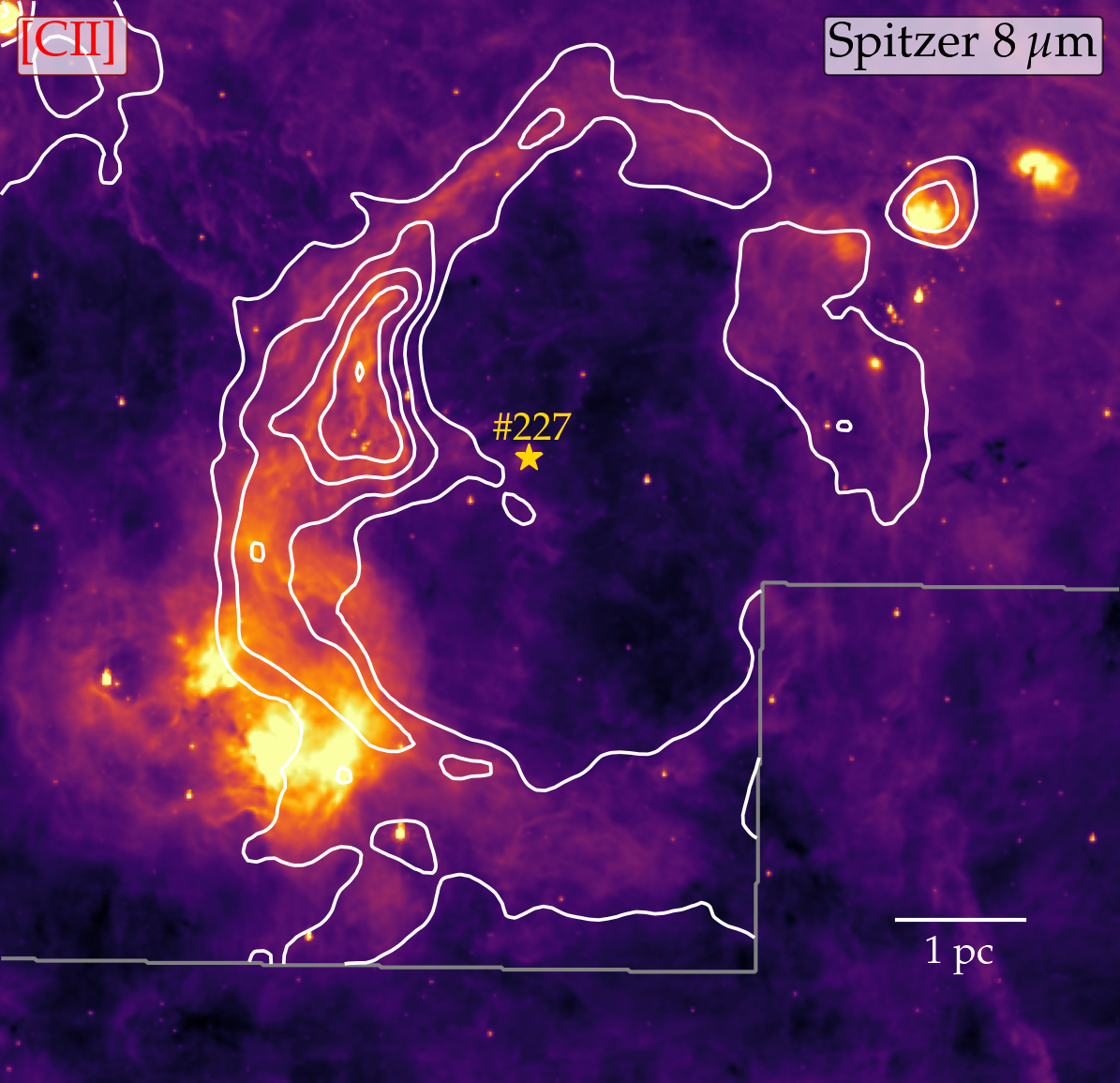
In our recent A&A paper (Dannhauer et al., subm.), we investigated the “Diamond Ring” in Cygnus X, a striking 6 pc wide ring-like structure seen in [C II] 158 μm and dust emission. Unlike the three-dimensional [C II] shells discovered in recent years, the Diamond Ring reveals itself as the first pure ring, slowly expanding at only ~1.3 km/s.
The [C II] data stem from velocity-resolved SOFIA/upGREAT maps from the FEEDBACK legacy program. Combined with archival molecular line data, dust continuum, radio observations, and new spectroscopy of the central star, we establish a picture of the nature of this object. The ring is powered by a B0.5e star located near its center which also creates an HII region in the ring cavity. Interestingly, the bright “Diamond” to the southeast of the ring is not part of the same structure, but an unrelated clump of dense gas and young stars at a completely different velocity along the line of sight.
We carried out dedicated 3D simulations of stellar feedback in a flat molecular slab, in order to follow the evolution of a ring-like structure. These simulations demonstrate that the Diamond Ring represents the terminal phase of a [C II] bubble evolving inside such a slab. In its early life, the bubble expanded in three dimensions. However, gas moving perpendicular to the plane of the slab quickly dispersed into the surrounding lower-density medium dropping below our detection limit, while the parts confined to the slab persisted as a coherent, slowly expanding ring.
From the observations and simulations, we derive an age of only ~400–500 kyr, much younger than classical estimates assuming spherical expansion, with cloud dispersal taking over after 100 kyr as also suggested by previous studies. The Diamond Ring highlights how the geometry of molecular clouds, especially flat clouds which might be common, fundamentally shapes stellar feedback.
-
B3: iEDGE: Star formation relationships for active and non-active galaxies at different stages of their evolution (Dario Colombo, Zein Bazzi, Frank Bigiel)
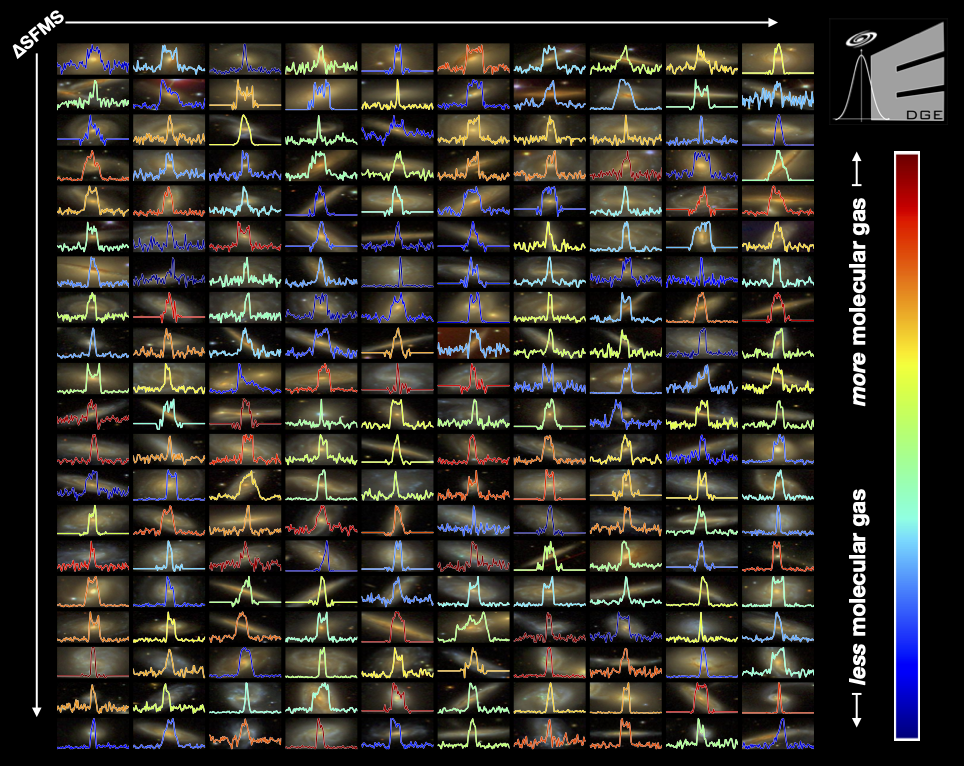
The process that brings galaxies to reduce and definitely halt to form stars (the star formation quenching) is the result of a complex interplay of phenomena that are difficult to disentangle without an adequate and statistically significant sample of galaxies. Given this, we have assembled the integrated Extragalactic Database for Galaxy Evolution (iEDGE), collecting stellar continuum, nebular emission lines, and molecular gas information for hundreds of galaxies in the local Universe. iEDGE is, to date, the most comprehensive and extensive database of (CO-based) integrated galaxy properties.
The first iEDGE paper (Colombo et al. 2025a, arXiv:2507.06375) introduces the homogenised database of 643 nearby CALIFA galaxies combining optical integral field unit (IFU) and CO measurements, revealing a strong bimodality between passive early-types and star-forming spirals, with centrally suppressed star formation efficiency (SFE) in passive systems nearly two orders of magnitude below typical global values.
Building on this, the second study (Colombo et al. 2025b, arXiv:2507.06406) examines how star formation scaling relations evolve along galaxies at different quenching stages, showing that molecular gas mass and gas fractions decline steadily from star-forming to retired galaxies, while SFE remains roughly constant during the transition before dropping sharply—particularly in galaxy centres—consistent with inside-out quenching.
Finally, the third paper (Bazzi et al. 2025, arXiv:2507.06709) explores the role of AGN activity in this process, finding that AGN hosts exhibit higher molecular gas masses at fixed quenching stage but follow similar SFE and gas fraction trends as non-active galaxies, suggesting no prominent instantaneous effects of AGN feedback on global star formation properties.
iEDGE will help to contextualise dedicated resolved studies of ageing galaxies, aiming to image the objects in which stars are actually born, the Giant Molecular Clouds, and understand whether their properties and dynamical states can explain why galaxies reduce their star formation efficiency in particular regions. Additionally, the database will be used to assess whether the quenching can be explained by a break in the transition from atomic to molecular to dense gas, by including information from the 21 cm line and dense gas tracers such as high-J CO and HCN transition lines.
Authors: Dario Colombo, Zein Bazzi, Frank Bigiel (AIfA, University of Bonn)
Figure: A collection of 200 CO spectra (roughly a third of the full amount included in the database) overplotted on the SDSS images of the galaxies. The panels are ordered by the logarithmic distance from the star formation main sequence (ΔSFMS), and they are colour-encoded considering the amount of molecular gas inferred from the CO detections. The randomness of the colour distribution suggests that an advanced stage of quenching is not necessarily implied by the absence of molecular gas. The iEDGE is available for download on Zenodo: https://zenodo.org/records/15822433. Image credits: D. Colombo, V. Kalinova, Z. Bazzi & the EDGE-CALIFA collaboration.
-
C5: Does the [CII]-molecular gas relation evolve over time? (Prachi Khatri)
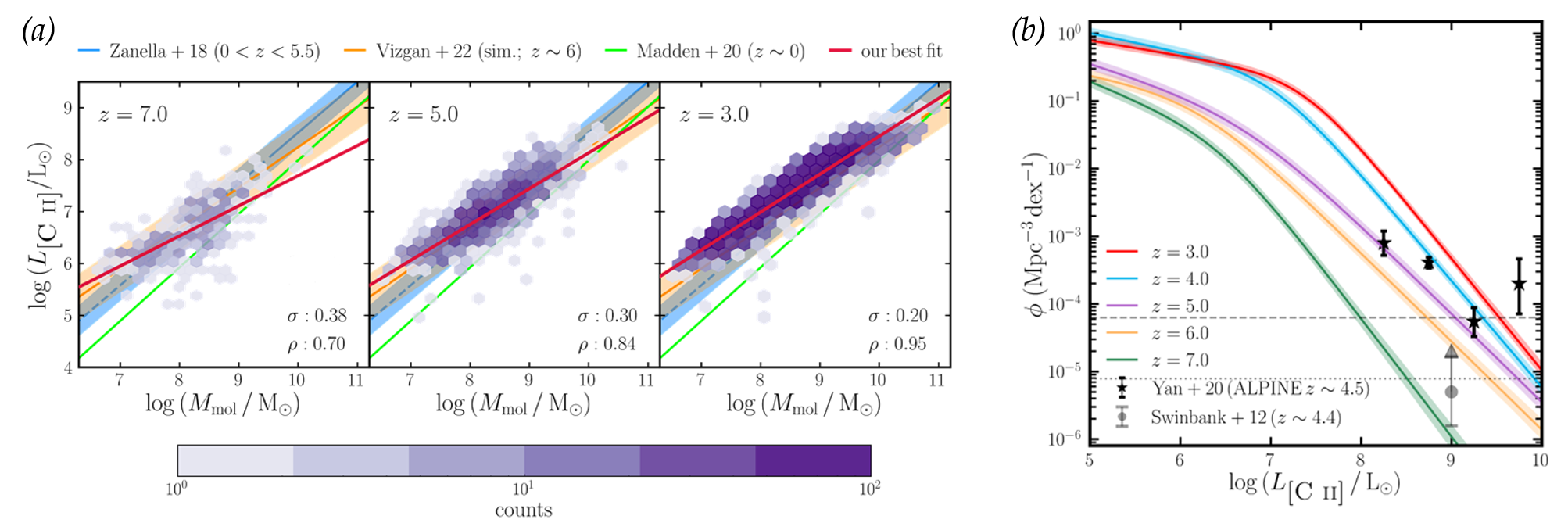
In recent years, the fine-structure line of C+ at 158 microns – the [CII] line – has gained significant attention as a molecular gas tracer, particularly at z ≳ 4. Being one of the brightest emission lines in galaxies, it offers a unique window into the molecular ISM of distant galaxies, where conventional tracers like CO become observationally expensive.
We have tested the reliability of this line as a tracer of the molecular gas mass (Mmol) using a statistical sample of galaxies at different cosmic epochs from high-resolution cosmological simulations – the Marigold simulations. Our analysis reveals that the [CII]- Mmol correlation is relatively weak at z ≳ 5, but becomes progressively stronger over time. We also identify a clear secondary dependence on the star formation rate (SFR), accounting for which, significantly improves Mₘₒₗ predictions by a factor of 2.3 at all redshifts.
We have further examined the time evolution of the [CII] luminosity function and the cosmic [CII] luminosity density (ρ[CII]) and found that faint (L[CII] < 107 L⊙) galaxies contribute nearly half of the cosmic ρ[CII] at z ≳ 7. Since these faint galaxies fall below the sensitivity limits of current instruments, detecting them would require alternative observational strategies.
The paper describing our findings has been published in A&A.
DOI: 10.1051/0004-6361/202453048Figure caption: a) Figure showing the redshift-evolution of the [CII]-Mmol relation in galaxies from the Marigoldsimulations. The purple bins show the distribution of simulated galaxies and the red line gives the ordinary least squares linear fit to these galaxies. The blue, lime, and orange lines show previous empirical and numerical estimates for specific redshifts. We note that the [CII]-Mmol correlation tightens and strengthens over time, as indicated by the decreasing scatter (σ) and increasing Spearman’s rank correlation coefficient (ρ) towards lower redshifts.
b) Figure showing the redshift-evolution of the simulated [CII] luminosity function (LF) and a comparison with observational estimates (in black). The coloured lines represent the best-fit double power-law to the simulated LF and the shaded area represents the central 68% credibility range obtained using MCMC chains.
-
B2: First-Detected Young Carbon-Filled Bubble in RCW79 Hides Its Carbon Emission (Eduard Keilmann, Simon Dannhauer, Nicola Schneider, Robert Simon)
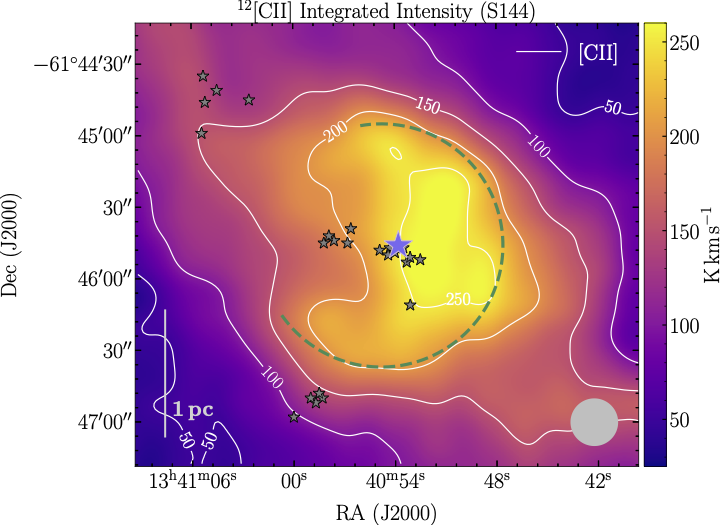
In our recent A&A Letter, we studied ionized carbon emission (C⁺, [C II]) at 158 μm in S144, a C⁺ bubble on the southeastern edge of the ring-shaped star-forming region RCW79. S144 hosts a compact H II region ionized by a single O7.5–9.5 V/III star. Using SOFIA/upGREAT maps with high angular and spectral resolution, we identified the first bubble that remains mostly filled with C⁺ gas – an indicator of an exceptionally early evolutionary stage. All previously characterized C⁺ bubbles exhibit shell-like rings with central cavities carved by stellar winds, marking more advanced phases.
We also uncovered an apparent shortfall in C⁺ emission relative to S144’s far-infrared luminosity: the so-called “C⁺-deficit,” long attributed to increased dust heating, cooling via other fine-structure lines, or intense radiation fields. Our analysis shows instead that cooler C⁺ gas in the bubble’s outer layers self-absorbs the emission from its warm interior, creating the illusion of a deficit.
By correcting for C⁺ self-absorption, we refine our view of how carbon governs gas cooling in star-forming regions and improve the interpretation of [C II] observations across both Galactic and extragalactic environments.
Paperlink: https://doi.org/10.1051/0004-6361/202453445
-
B4: The first high frequency C-band RM Grid of the Galactic plane: A Faraday Rotation study using the GLObal view on STAR formation survey (Anahat Cheema, Ann Mao)

Magnetic fields are a key component of the interstellar medium, influencing star formation and galaxy evolution. To better understand their structure and strength, we use data from the GLObal view on STAR formation (GLOSTAR) survey to investigate magnetic fields in the plane of the Milky Way. Our study focuses on the Faraday effect – quantified by rotation measures (RM) towards background polarized radio sources to construct the first C-band RM grid. The small channel width in wavelength squared (~1.5 to 5 cm2) at C-band makes it well suited for identifying polarized sources with extreme RMs (~3000 rad m-2 at a channel width of 200 MHz), which would likely be completely bandwidth depolarized in lower-frequency surveys. GLOSTAR’s higher frequency coverage also significantly reduces depolarization effects from foreground Galactic turbulence, enabling us to probe previously obscured, dense regions of the Galaxy.
The GLOSTAR survey covers a significant portion of the Galactic plane (-2° < l < 60° and |b| < 1°), using the Karl G. Jansky Very Large Array (VLA) in D and B array configurations and the Effelsberg 100 m telescope within the 4-8 GHz C frequency band. The data products include Stokes IQU cubes covering mosaics of 16 square degrees from VLA-D and 2 square degrees from VLA-B configuration, observed at nine distinct frequency intervals across C-band.
We detected 74 polarized sources, out of which 71 are identified in polarization for the first time, within the pilot region of the survey (28° < l < 36° and |b| < 1°) having peak-pixel percent polarization of more than 5% and greater than 7-sigma detection in polarization. We determined the rotation measure values by performing a linear fit to the multi-frequency polarization angle measurements at 9 distinct GLOSTAR spectral windows as a function of λ2. The preliminary RM grid has a source density of approximately 5 RMs per square degree which is ~ 5 times denser than the current state-of-the-art RM grid on the Galactic plane. The maximum |RM| detected is 1042.37 rad m-2, the standard deviation of the 74 RMs is 437 rad m-2 with a typical RM uncertainty of ~ 40 rad m-2.
C-band observations reveal significantly higher |RM| values and source-to-source dispersion than those seen in low-frequency surveys, offering a much more complete view of the magnetic field structure in the Milky Way. After properly quantifying wide field instrumental polarization effects, we will be able to recover more reliably polarized sources below 5% in percent polarization, resulting in an even denser RM grid. We will next apply RM synthesis to determine RMs and to resolve possible complex Faraday structures, and subsequently extend this method to encompass the entire GLOSTAR footprint, providing brand new insights into the Galactic magnetic field in Galactic quadrant 1.
Figure: The Rotation Measures of the polarized sources in the GLOSTAR pilot region, overplotted on the VLA-D + Effelsberg image. The previously reported RMs in the Consolidated RMTable (Van Eck et al. 2023) are also shown with different markers shown in the legend.
-
A1: Hot cores in the outer Galaxy: impact of metallicity on the formation of complex organic molecules (Youxin Wang, Arnaud Belloche)

Understanding the formation of complex organic molecules (COMs) in star forming regions is crucial for astrochemistry. Many COMs are believed to form on the surfaces of dust grains or in their ice mantles. The metallicity and dust-to-gas mass ratio in the outer Galaxy are lower than in the inner regions and are expected to influence the chemical composition of star-forming environments. To test this, we used the NOEMA interferometer to conduct a sensitive imaging spectral line survey of a hot core candidate located at a galactocentric distance of 13 kpc.
We identified 43 molecular species in the spectrum of this source, including less abundant isotopologs and deuterated species. Among them, 12 COMs containing up to ten atoms were detected in a compact (<5000 au), hot (>100 K) region. These findings confirm this source as a new hot core in the outer Galaxy, providing an excellent opportunity to study COM formation under low-metallicity conditions.
We derived rotational temperatures and column densities of the detected molecules and compared our results with simulations performed with the three-phase astrochemical code MAGICKAL. The models predict that certain molecules exhibit significantly reduced abundances (relative to methanol) at low metallicity and dust-to-gas mass ratio, while the abundances of other species remain relatively unchanged. Our observations are broadly consistent with these predictions when comparing COM abundances in this source to those in hot cores and hot corinos in the inner Galaxy. These results suggest that metallicity and the dust-to-gas mass ratio have an impact on the formation of COMs (paper in preparation).
Figure caption: part of the NOEMA spectral line survey of the new hot core in the outer Galaxy. The contributions of selected molecules to the observed spectrum are shown in various colors.
-
B5: Modelling the environment that shapes an RCW 103 supernova remnant (Ekaterina Makarenko)
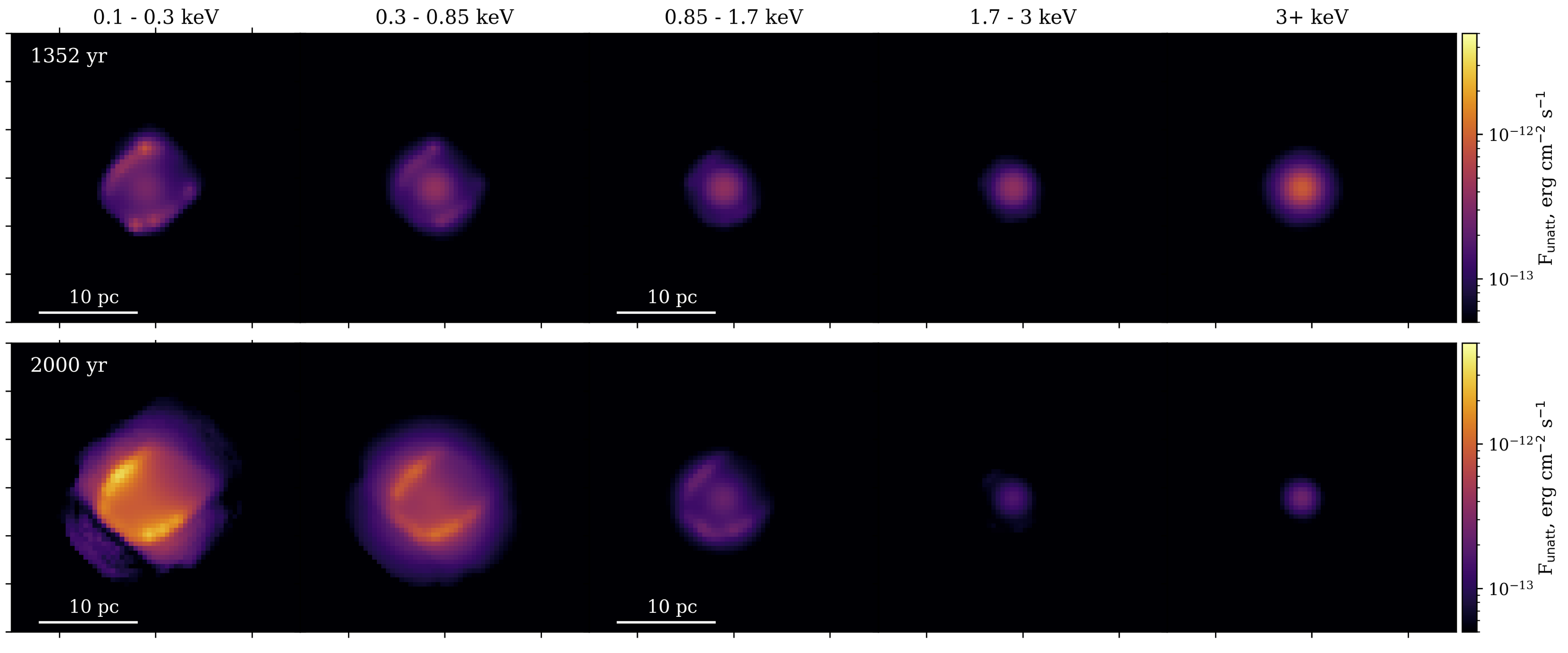
Massive stars (M > 8 solar masses) significantly affect the surrounding medium during their life through stellar winds and ionising radiation. These processes shape the circumstellar medium (CSM) into complex structures, including cavities. When a massive star explodes as a supernova (SN), the resulting shock wave expands into this non-uniform medium, generating bright X-ray emission. As a result, X-ray observations of SN remnants (SNRs) provide insights into the stellar evolution of a progenitor massive star and the interstellar medium (ISM) nearby.
RCW 103 is a young (∼2000 years) Galactic SNR that has begun interacting with its CSM. Despite evidence of an initially asymmetric density distribution at the explosion site, its observed X-ray morphology appears almost circular with a slight asymmetry towards the southwest. The cause of this morphology remains unclear. To explore this, we perform 3D (magneto-)hydrodynamic simulations using the FLASH code, incorporating radiative cooling and self-consistent treatment of X-ray emission.
We simulate the evolution of a massive star (18 M solar masses) in a uniform ISM, including the effects of ionising radiation and stellar winds. After the SN event, we track the shock propagation and X-ray emission across multiple energy bands, similar to Chandra observations. An example of synthetic X-ray maps in the corresponding energy bands is shown in Figure 1. As the progenitor star is not stationary, the stellar wind cavity is asymmetrical, leading to a brighter X-ray emission at the edges.
This is an ongoing project that focuses on identifying the primary reason responsible for the morphology in RCW 103’s X-ray emission. Possible explanations include the progenitor star’s runaway velocity, which caused a bow shock to form, the influence of interstellar magnetic fields, or a nearby molecular cloud. Modelling these effects will improve our understanding of SNR-ISM interaction.
-
A4: Deciphering the Rotational Fingerprints of Vibrational States (Luis Bonah)
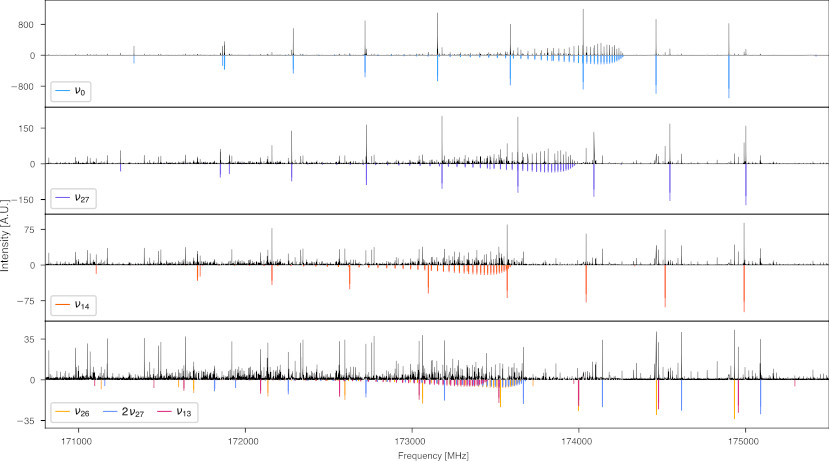
We analyze molecules in the laboratory to find their spectroscopic “fingerprints”, which astronomers can use to identify the molecules in space. Unlike a human fingerprint, the molecular fingerprint also reveals physical properties of the molecules’ surroundings. The temperature of the astronomical regions can be determined by comparing the relative intensities of different transitions of a molecule. In an ideal case, the transitions belong to different vibrationally excited states of the molecule. Therefore, analyzing also the rotational spectra of vibrationally excited states, the so-called vibrational satellites, in the laboratory is important. However, due to the higher vibrational energy, their population usually is very much lower compared to the ground vibrational state making it harder to find their patterns in the spectrum.
The figure shows a small part of the rotational spectrum of cyclopentadiene. The top row shows the predictions for the ground vibrational state in blue and the experimental data in black (maximum intensity of 800 A.U.). Going to the second row, all experimental data around the ground state predictions are removed to highlight the weaker pattern (maximum intensity of only 150 A.U.) of the vibrational state v27 with the corresponding predictions being shown in purple. Similarly, rows three and four show the spectrum after additionally removing the lines corresponding to v27 and v14, respectively.
Unfortunately, a few experimental lines are missing in the last two rows as they are blended with lines of already removed states. Nonetheless, this procedure greatly facilitates the identification of vibrational satellite spectra and nicely highlights their different intensities. -
A3: Exploring the Evolution of Stellar Multiplicity in Massive Star-Forming Clusters (Emma Bordier, Chinmaya Nagar)
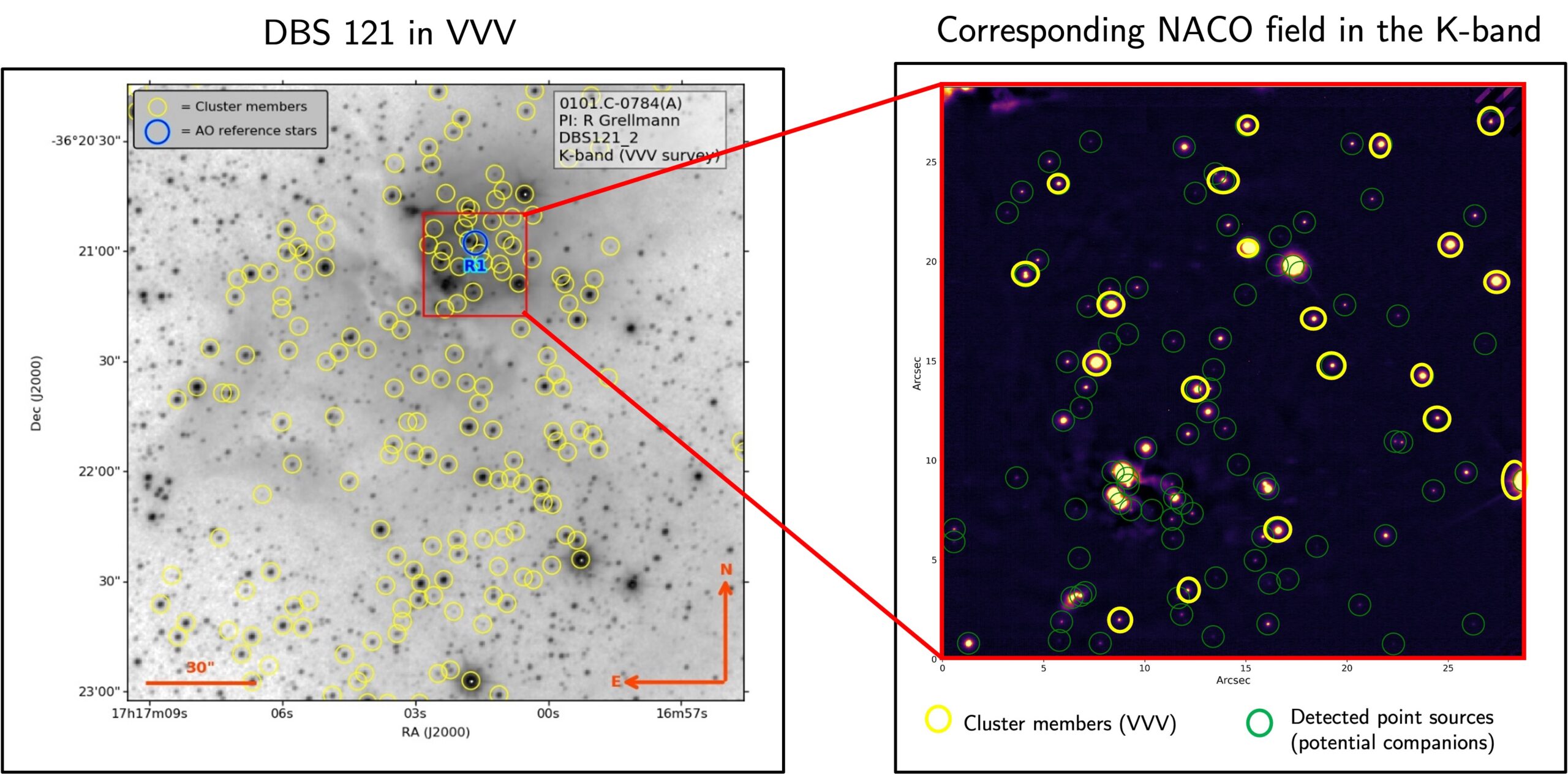
Understanding how stars form and evolve is one of the most fascinating challenges in astronomy. A key piece of this puzzle is the stellar multiplicity—the frequency, separations, and mass ratios of stars that form in pairs or higher-order groups. Massive stars, which make up only 0.01% of all formed stars, play a pivotal role in shaping galaxies and the universe. Understanding their life cycle—90% of which unfolds alongside at least one companion—is therefore of paramount importance. Yet, they are particularly difficult to study since they are heavily bloated in their dusty envelopes and are born in distant, dense, and young star clusters. These observational challenges leave significant gaps in our understanding of how their multiplicity evolves over time.
To help fill this gap, our team conducted high-resolution observations to explore the properties of stars that have just formed or are still in the process of forming, within four massive, near-primordial clusters. We identify potential binary or multiple star systems, study how their properties—such as separation and mass ratios—vary within and between clusters. In this framework, multiplicity serves as a tool to trace the initial conditions that drive the formation of massive stars in multiple systems.
To study the primordial multiplicity properties, the clusters must have similar chronological ages with slight variations and be young enough to ensure that significant dynamical interactions have not yet occurred. This increases the likelihood of observing systems in a near-primordial multiplicity state. The selected clusters—Hourglass Nebula, RCW 108, DBS 113, and DBS 121—are observable in the near-infrared and submillimeter wavelengths due to their significant dust emission. These clusters are located at a distance of 1.5 ± 0.3 kpc on average and can be classified by age. Based on this cluster classification, we trace the evolution of multiplicity and companion fraction between 1.0 Myr and 2.8 Myr.
Our preliminary results are derived from NACO K-band data, with Chinmaya, a PhD student in our team, leading this aspect of the project. The figure shows one of the fields of DBS121 for which we show the identified sources, hence potential companions per bin of separation. We find that multiplicity properties evolve with cluster age, as the other clusters show a gradually increasing trend in the number of stars, thereby indicating a possible increase in companion fraction with cluster age. To extend this study, we recently included VVV CL100 (7.5 Myr) to determine whether this trend persists in older clusters.
Emma, a postdoc in our team, successfully led an ALMA proposal to enhance this analysis. Data acquisition is now underway, promising exciting new discoveries in the evolution of multiplicity properties in massive star-forming clusters. Stay tuned!
-
B7: 8-Port Power Divider for the CHAI Receiver (Matthias Justen)
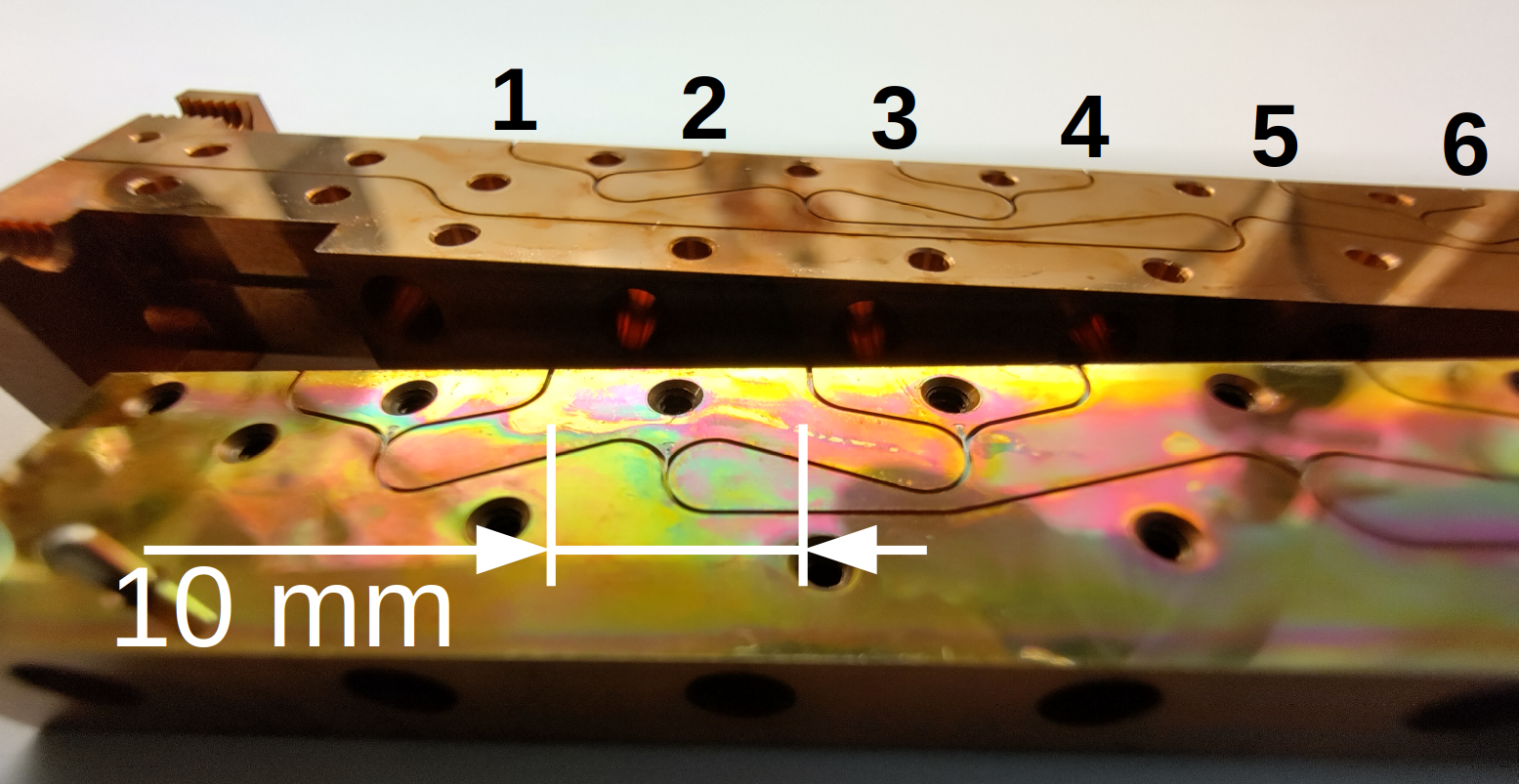
We are currently building the CCAT Heterodyne Array Instrument (CHAI) to be operated at the FYST-telescope. CHAI is a 64-pixel high-resolution spectrometer for two frequency bands around 460 GHz (650 µm) and 800 GHz (370 µm). For optimum instrument stability, CHAI uses balanced SIS mixers, which receive their Local Oscillator (LO) signal through an input port separate from the measurement signal input.
In order to distribute the LO power to the individual mixers, we developed a waveguide power splitter with an extremely even splitting ratio over the required bandwidth. Since the LO source is distributed to up to 32 mixers, we are employing a 5-level cascade of this divide-by-two splitter. Excessive asymmetry in the splitting ratio of a single unit would result in unacceptable power differences between the outputs of the cascade. Each of our splitting stages uses a simple Y-junction, upgraded by a drop-in chip, which suppresses crosstalk between the two outputs.
In order to illustrate the suitability of the concept for a multi-level cascade of binary splitters, we built the first section of CHAI’s LO distribution network: a 3-level cascade, which results in 8 equal output ports to serve one row of 8 mixer blocks in CHAI’s focal plane. The photograph shows a device manufactured as E-plane split block at our precision workshop. Waveguide dimensions are 0.460 mm x 0.230 mm for the low-frequency band of CHAI (420 – 510 GHz). Visible at each junction are the chips (600 µm x 60 µm) for the isolation between the output ports, which were manufactured in our microfabrication lab.

The graph shows the output power distribution measured at the 8 output ports of the 3-level cascade over the nominal bandwidth. No systematic asymmetry can be seen in the signal. The maximum power scatter – including significant measurement noise – is below 40% of the nominal output power – well within our tolerance range.
Title figure: Photograph of the two split-block halves of the 8-way power divider, showing the waveguides with the isolator chips. Output ports are numbered.
-
A3: An intermediate mass black hole in the center of our galaxy (Florian Peißker)
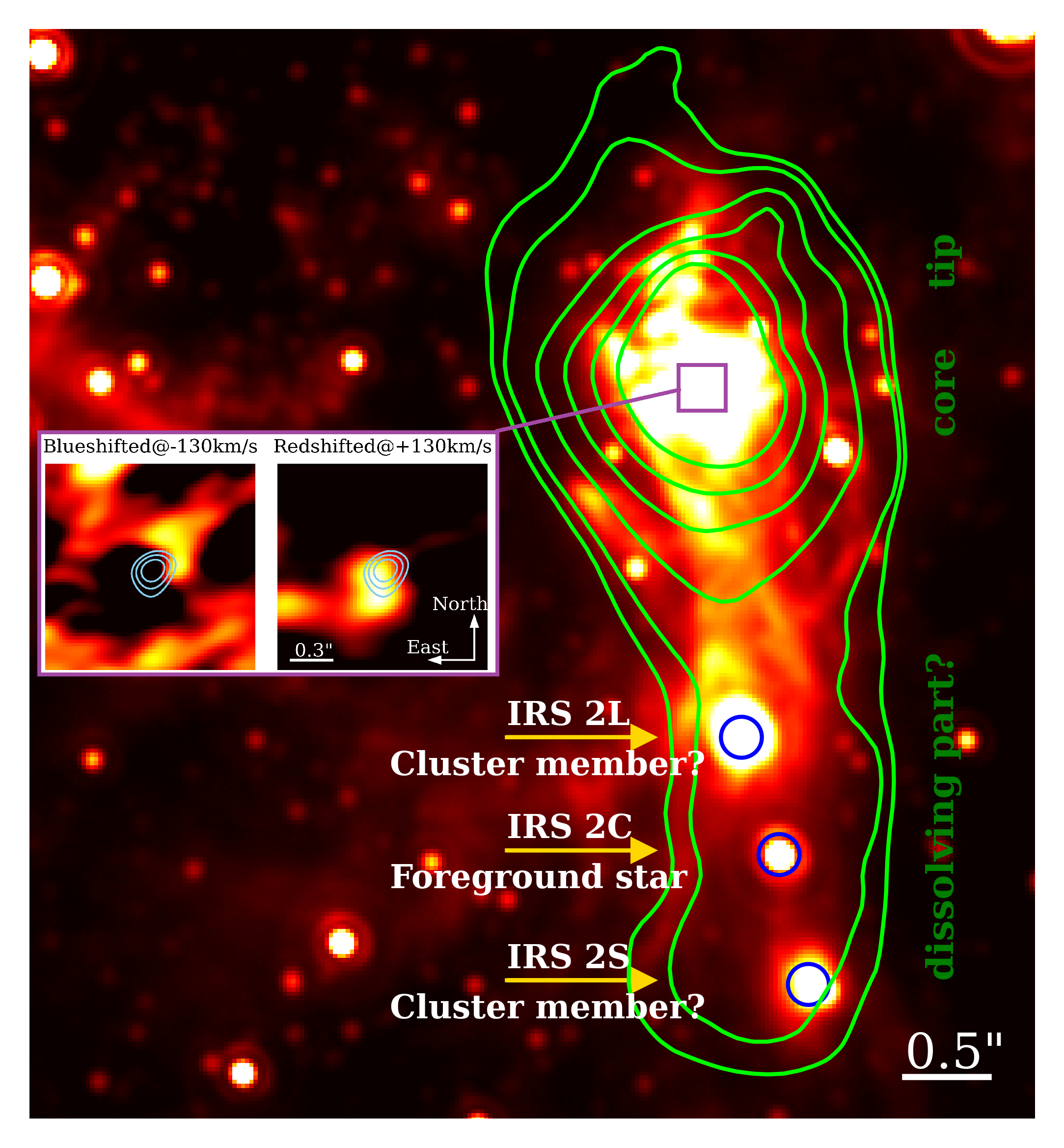
To date, the growth mechanism of supermassive black holes (SMBHs) is a scientific mystery. If we consider the accretion rate of the SMBH in our Milky Way, Sagittarius A* (Sgr A*), and the age of the universe, a discrepancy of several magnitudes in its mass opens up. One proposed idea to overcome the mismatch of accretion rate and age of the universe is merging events between intermediate-mass black holes (IMBHs) that ultimately form SMBHs. However, only around 10 IMBHs in our entire universe have been confirmed by observations, which poses a significant challenge to the theory of merging black holes. In Peißker et al. (2023c) and Peißker et al. (2024b), we have analyzed the densest stellar cluster, IRS 13, in our Milky Way, only about 0.3 lightyears away from Sgr A*. This massive embedded cluster shows two distinct generations of stars, implying independent and plausible triggered, star formation events. Until recently, it was unclear how and why this cluster so close to an SMBH seems to preserve its shape. As we show in both related publications, the cluster comprises three distinctive components. One of the components is associated with the dense core of the cluster, whereas the other one shows signs of evaporation. We argue that IRS 13 is the remanent of a more massive cluster that plunges into the gravitational well of our central SMBH. One key aspect of this analysis is the young age of the two stellar populations. From the young age and plausible star formation channels, we derive an unusually short cluster migration timescale. One explanation for the rapid infall of the cluster could be the presence of an IMBH inside the cluster. In Peißker et al. (2024b), we confirm that the presence of an IMBH is highly likely. Due to the evaporation nature of the cluster, it is expected that we identified one of the first pre-merger setups between an SMBH and IMBH to date.
-
B3: PHANGS-JWST: Molecular cloud identification using 7.7μm MIRI data (Z. Bazzi, D. Colombo, F. Bigiel)
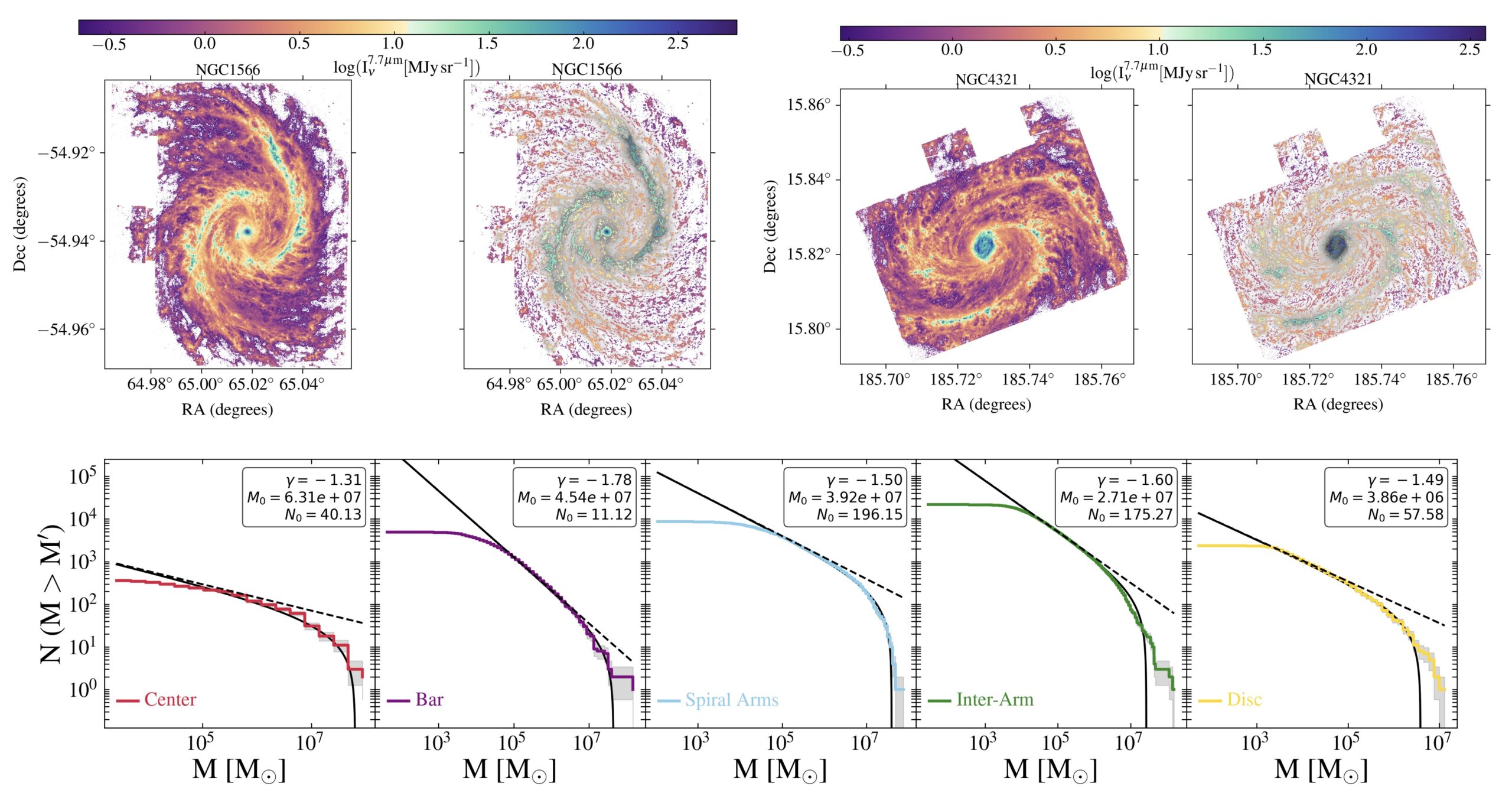
Stars form within molecular clouds, dense regions of cold gas primarily composed of molecular hydrogen. These clouds provide the necessary conditions for the formation of stars, including low temperatures and high densities, which allow gravitational forces to overcome thermal pressure and initiate the collapse of gas. To fully understand the process of star formation and therefore the evolution of galaxies, it is crucial to study the properties of molecular clouds—such as their mass, density, distribution, and relation to the galactic environment.
The Physics at High Angular resolution in Nearby GalaxieS (PHANGS) collaboration aims to create a comprehensive view of star formation and the lifecycle of gas and dust in nearby galaxies, using state-of-the-art facilities. In particular, by leveraging the James Webb Space Telescope (JWST)’s infrared capabilities, the PHANGS-JWST program has provided astonishing views of 19 galaxies in wavelengths that are typically obscured by dust in the optical range, reaching unprecedented resolutions and sensitivities.
We used observations of the emission from Polycyclic Aromatic Hydrocarbons (PAHs, e.g. complex organic molecules that emit strongly in the mid-infrared and are associated with photodissociation regions) from PHANGS-JWST to generate molecular gas maps of the 19 galaxies.
The application of the Spectral Clustering for Molecular Emission Segmentation (SCIMES) on the JWST data allowed the identification of more than 50,000 highly-resolved molecular clouds. SCIMES is a machine learning-based code that utilises graph theory concepts to segment out molecular clouds from the more diffuse medium by preserving their intrinsic morphology and internal structure.
Our preliminary results suggest that the molecular cloud mass spectra—specifically their steepness and truncation mass—are strongly influenced by the surrounding dynamical environment. This indicates that certain physical conditions may be more favourable to the formation of high-mass clouds than others.
Figure caption: Upper row: Left image shows the galaxy’s intensity map; right image displays dust structures identified by SCIMES with a greyscale intensity background and a colour bar indicating 7.7 μm intensity. Bottom row: Cumulative mass distributions of molecular clouds in different environments. Dotted black lines represent simple power-law fits; solid black curves are truncated power-law fits. Fit parameters—γ (spectral index), M0 (maximum mass), N0 (count in the distribution). The grey region represents the Poisson errors on the counts.
-
C6: Constraining warm dark matter with intensity mapping of the [CII] fine-structure line (Elena Marcuzzo)
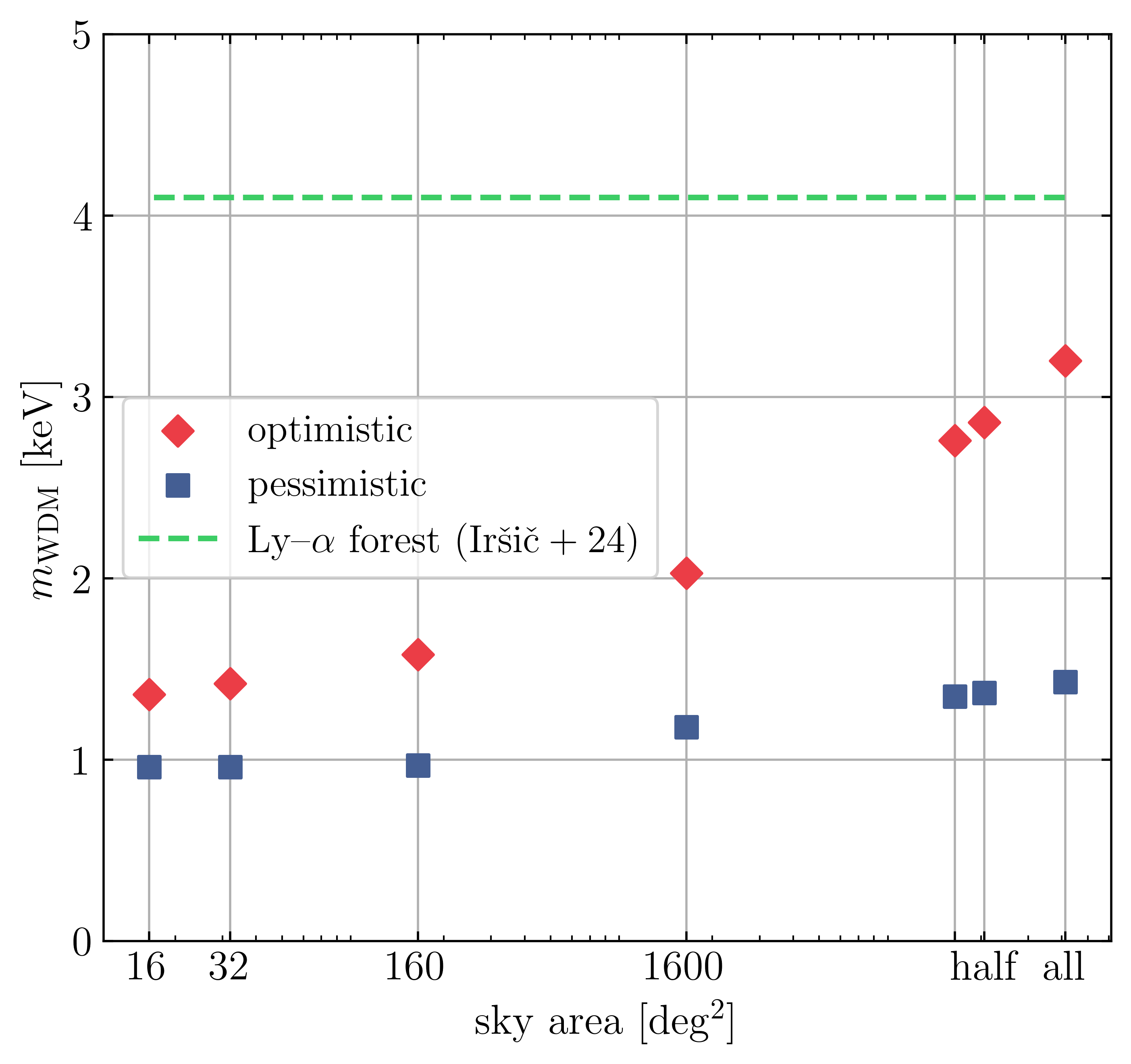
Line Intensity Mapping (LIM) is an emerging technique in radio-astronomy that scans vast fractions of the sky with a large beam and detects the integrated emission of all sources along the line of sight without resolving individual objects. This approach enables probing the high-redshift Universe including the contribution from intrinsically faint sources that traditional surveys miss due to their flux-limit thresholds. These peculiarities make LIM an ideal tool to probe the nature of dark matter (DM).
Most particle-physics candidates for DM fall into the class of thermal relics (i.e. particles that were once in thermal equilibrium with the rest of the Universe). In this case, the velocity dispersion of the particles at early times turns out to be inversely proportional to their mass. This implies that less massive particles can freely stream out of shallow potential wells and, de facto, inhibit the formation of low-mass structures. Therefore, cold DM (CDM, with negligible velocity dispersion) and warm DM (WDM, with a free-streaming length of the order of 0.1 Mpc) give rise to a different mass spectrum of DM halos within which galaxy formation takes place.
Using the halo-model approach, we make forecasts for the constraints that LIM of the 150 μm fine-structure transition of [Cii] can set on the mass of the DM particles. Ionised carbon is a promising tracer that should be present also in low-mass halos, contrary to neutral hydrogen that cannot be shielded from the UV background after cosmic reionisation. We compress the data into the isotropic power spectrum and use Bayesian inference marginalising over the uncertain faint-end slope of the [Cii] luminosity function (LF).
Our results are shown in the figure as a function of the survey area and for two different measurements of the bright-end of the [Cii] LF (optimistic/pessimistic). Assuming a CDM scenario, we find that LIM can rule out WDM particle masses up to 2–3 keV, which makes this technique competitive with other probes, such as the Ly-α forest. Our study demonstrates that, taking into account the current limits on the LF, the [Cii] power spectrum is dominated by sources hosted in relatively massive halos and this diminishes its constraining power on the WDM mass.
Paper: Marcuzzo et al. (2024)
-
C5: HYACINTH – A New Model for Molecular Hydrogen and Carbon Chemistry in Cosmological Simulations (Prachi Khatri)
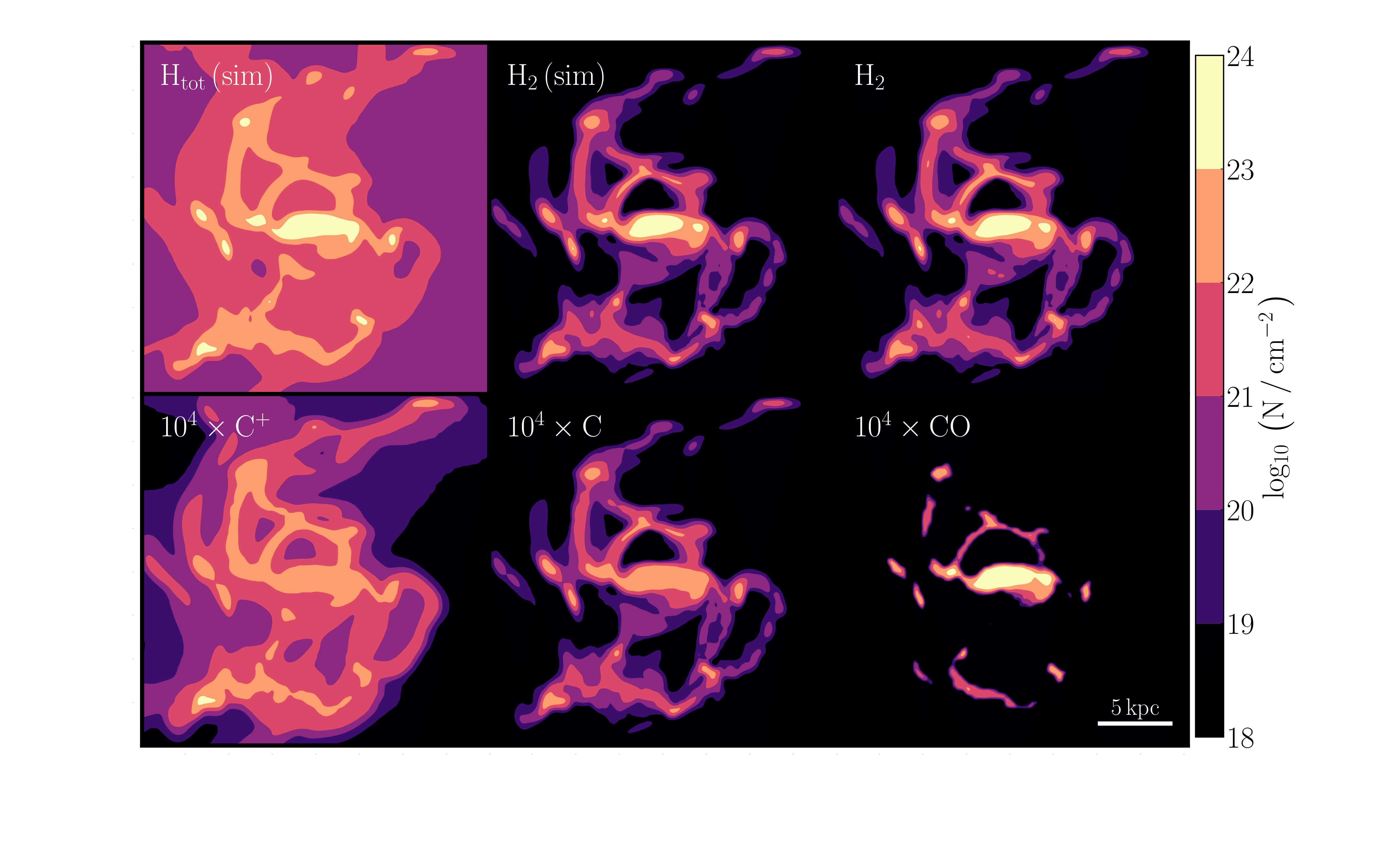
Modelling the molecular gas content of galaxies is a highly non-linear, multi-scale problem in astrophysics. On one hand, it is necessary to simulate galaxies in realistic environments as they are affected by outflows and gas accretion from the cosmic web. On the other hand, molecular-cloud chemistry is regulated by conditions on sub-parsec scales.
To overcome this challenge, we have developed a new sub-grid model, HYACINTH – HYdrogen And Carbon chemistry in the INTerstellar medium in Hydro simulations – that can be embedded into cosmological simulations of galaxy formation to calculate the non-equilibrium abundances of molecular hydrogen and its carbon-based tracers, namely, CO, C, and C+ on the fly. Our model captures the effects of the ‘microscopic’ (i.e., unresolved) density structure on the ‘macroscopic’ (i.e., resolved) chemical abundances in cosmological simulations using a variable probability distribution function of sub-grid densities within each resolution element.
The chemical abundances from HYACINTH are in good agreement with observations of nearby and high-redshift galaxies. We are now running a suite of cosmological galaxy formation simulations with HYACINTH that will allow us to address fundamental questions regarding the contribution of different galaxies to the global H2 budget and the reliability of different molecular gas tracers across ISM conditions and galaxy environments at high redshifts (z ≳ 3).
The paper describing the model has been accepted for publication in A&A.
DOI: 10.1051/0004-6361/202449640Figure caption: Column density maps of different species in a pre-simulated galaxy (from Tomassetti et al. 2015) post-processed with HYACINTH. The first two panels show the distribution of total and molecular hydrogen from the simulation, while the other panels show the species obtained in post-processing. CO is concentrated in regions with the highest N(H2), while C and C+ are more widespread; C+ even extends out to regions lacking a significant amount of H2and closely mirrors the total gas distribution.
-
A4: First Measurements of the rotational Spectrum of Phosphabutyne (Sven Thorwirth, Luis Bonah)

Many places in space are too far away to learn about them by sending spacecraft there. So they cannot be examined directly but instead, we can learn about them by analyzing their emitted light.
Due to quantum mechanics, each molecule has a set of characteristic transition lines that uniquely identify it. When these transition lines are found in the emitted spectrum, we can be sure that the respective molecule appears in the observed object.
However, to identify molecules in space, we first have to understand their characteristic patterns in the laboratory. We do so by measuring the rotational spectrum of the molecules in our experiment and then fitting quantum mechanical models to them. These models can then be used by astronomers to identify the molecules in space and also to infer the physical conditions of the corresponding regions in space. For example, the temperature can be deduced from intensity relations, the pressure from the lineshape, and the molecule’s abundance can be inferred from its intensity.
Here, we measured the pure rotational spectrum of phosphabutyne (C2H5CP) for the first time and analyzed its vibrational ground state as well as its three singly 13C-substituted isotopologues. This will allow astronomers to search for phosphabutyne in space and determine the prevailing conditions of the corresponding regions. The figure shows a section of the measured broadband spectrum on top, highlighting the pattern repeating with the total angular momentum quantum number J, while the zoom-in on the bottom highlights the very good agreement between the calculated and measured spectrum, especially when applying a small shift of 126 MHz.
This work was performed in collaboration with Jean-Claude Guillemin (University Rennes) and Michael E. Harding (KIT). -
A6/B2: First detection of ionized carbon in a high latitude cloud raises new questions (Nicola Schneider, Volker Ossenkopf-Okada)
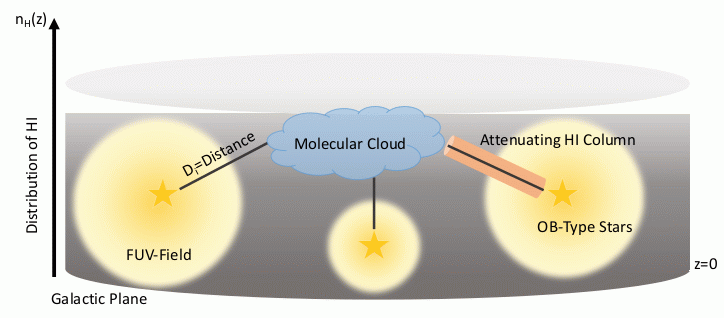
What is the structure and chemical composition of gas that may feed future star formation? Before interstellar gas turns dense enough to form new stars it is not fully molecular yet but in some so far unknown transitional state. A special case of such gas clouds are given by high-latitude clouds representing material that may fall onto the plane of the Milky Way.
In a recently accepted paper by Nicola Schneider and collaborators we reported results from SOFIA/upGREAT observations of a number of diffuse and high latitude clouds in the Milky Way, in particular the Draco, Spider, Polaris and Musca clouds. In only one of them, the Draco cloud, we detected emission of ionized carbon in spite of it being neither the densest cloud nor the one irradiated the strongest by known sources.
When trying to model the emission of all observations in terms of an astrochemical model of a photon-dominated region it turns out, that the model is not able to simultaneously explain the strength of the continuum emission from dust and the ionized carbon line. The ionized carbon detection and also the non-detections suggest a very low impinging UV field well below what is actually observed taking all the known stars in the environment. For the Draco cloud we can explain the difference by the additional energy from a shock that is produced when the cloud is hitting the interstellar gas of the Milky Way and some shielding of the cloud by interstellar dust in atomic gas. However, for the other clouds, we do not have a consistent explanation yet.
The paper combined the results from a fruitful collaboration between the CRC 1601 subprojects B2 and A6.Figure caption: Schematic illustration of the illumination of a high-latitude cloud by UV radiation from stars in the plane of the Milky Way. The orange cylinder along the path between star and cloud indicates the dust column which attenuates the UV-field.
-
B6: SILCC-FUV: The Influence of Far-Ultraviolet Radiation on Star Formation and the Interstellar Medium (Tim-Eric Rathjen)
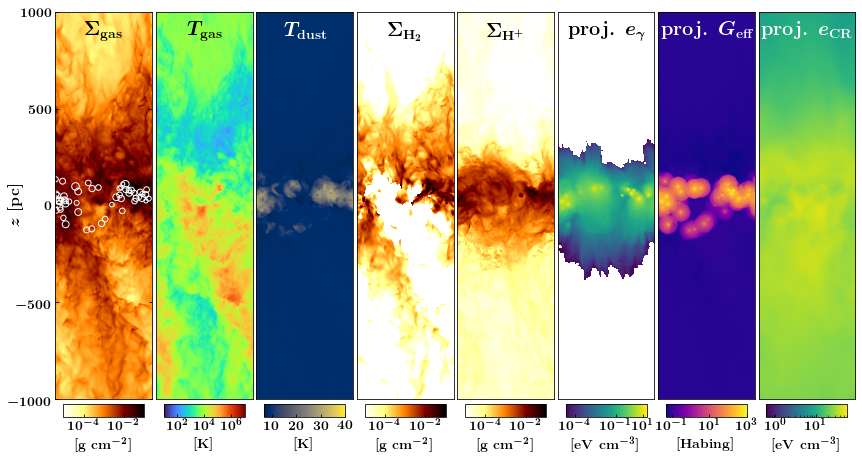
What roles do different stellar feedback processes play in governing star formation? From ionizing and non-ionizing radiation to stellar winds and supernovae, these forces interact with the surrounding stellar nurseries. However, understanding the precise significance of each process in shaping star formation remains an ongoing challenge.
We present new magneto-hydrodynamic (MHD) simulations conducted within the SILCC framework, exploring the multiphase interstellar medium (ISM) within a patch of a stratified galactic disk. Our study incorporates a self-consistent modeling of non-ionizing far-ultraviolet (FUV) radiation emitted by stellar clusters, aiming to understand its impact on star formation and the chemical composition of the nearby ISM. We observe locally intense interstellar radiation fields (ISRF) with values up to G0 ≈ 104 (in Habing units), contrasting with the canonical solar neighborhood value of G0 = 1.7.
Our findings suggest that while FUV radiation influences star formation, its role in regulating the star formation rate (SFR) appears less significant compared to other stellar feedback mechanisms such as ionizing UV radiation, stellar winds, and supernovae. Additionally, our chemical analysis reveals enhancements in both the warm-ionized medium (WIM) and the cold-neutral medium (CNM) beyond the vicinity of stellar clusters, indicating a complex interplay influenced by the self-consistent and highly variable FUV radiation field, fostering the presence of a diffuse molecular hydrogen gas phase.
Further details will be available in Rathjen et al., currently in preparation.
Figure: Overview of the simulated ISM. Shown are the edge-on views of the total gas (Σgas, 1st panel), molecular hydrogen (ΣH2, 4th panel), and ionized hydrogen (ΣH+, 5th panel) column densities, as well as mass-weighted gas (Tgas, 2nd panel) and dust (Tdust, 3rd panel) temperatures and ionizing photon energy density (eγ, 6th panel), the effective G0 field (Geff, 7th panel), and cosmic ray energy density (eCR, 8th panel) in projection. The star-forming galactic ISM is concentrated around the midplane. White circles in the 1st panel indicate active star clusters.
-
A2/A5: Confronting Simulations and Synthetic Observations (Birka Zimmermann)
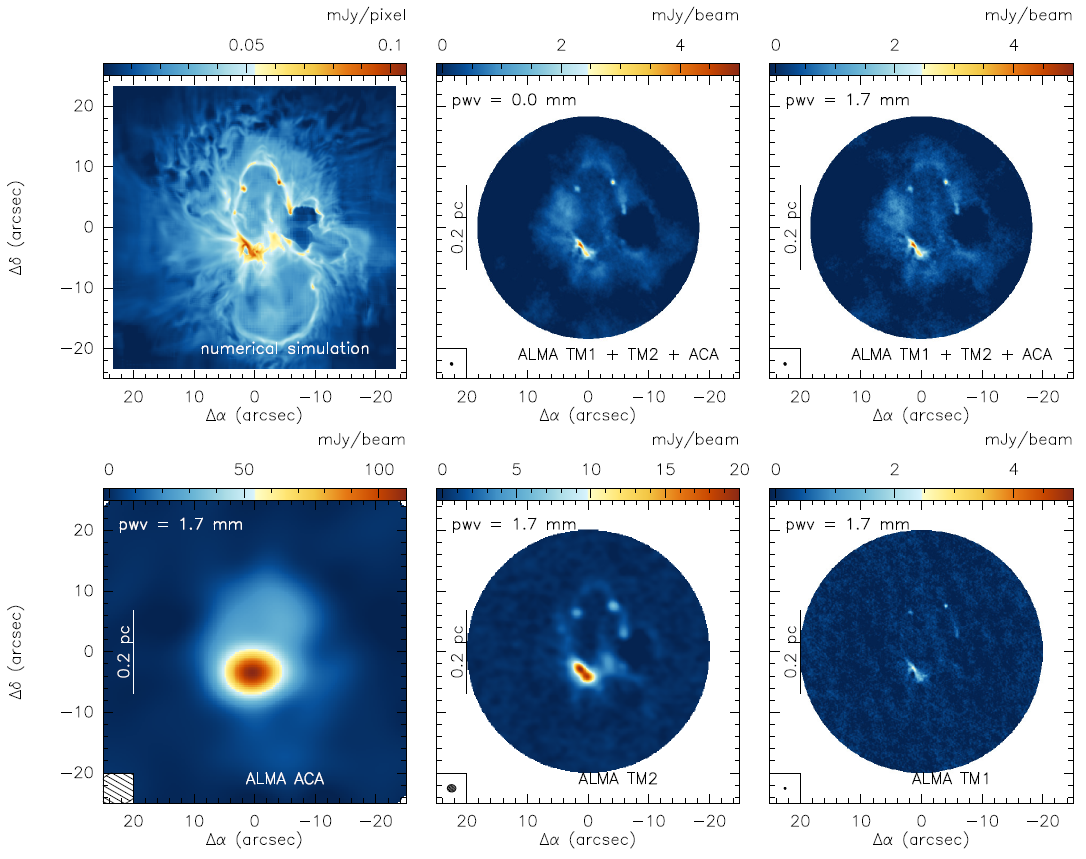
To learn more about the formation and evolution of massive stars it is important to confront simulations and observations.
It is useful to interpret the observational data and to extract the cores’ physical parameters,. We can address e.g. the question how massive cores fragment and form (massive) stars, or how long the young, massive stellar objects are embedded in their parental core.
Doing so, we simulate a collapsing core scenario of a subvirial, 1000 M☉ core with an initial radius of 1 pc and a linear magnetic field of 100 μG, which is a birthplace of massive stars.
For the post-processing we use RADMC-3D, which is an open source radiative transfer code that is based on the Monte-Carlo method. Here, we present synthetic observations of the dust emission (top left panel). The advantage of our simulations is that we calculate the dust temperature self-consistently, hence taking into account radiative heating by all young stars as well as shock heating. Thus, RADMC-3D is directly working on the simulated dust temperature. These results are post-processed with CASA, where different, respectively a combination of, possible ALMA channels and predictable water vapour (pwv) in the atmosphere can be simulated.
We show the results for synthetic observations in different ALMA channels (labeled with AMLA TM1, TM2 and ACA; bottom panels), as well as their combination for two predictable water vapour settings (top middle and top right panel). In synthetic observations most of the structures in the less dense environment are not visible anymore; however, the emission of the main star forming regions remain.This work was performed in collaboration with Dr. Álvaro Sánchez-Monge
